
|
||
|
Portland art blog + news + exhibition reviews + galleries + contemporary northwest art
|
||
Plethora Lucida 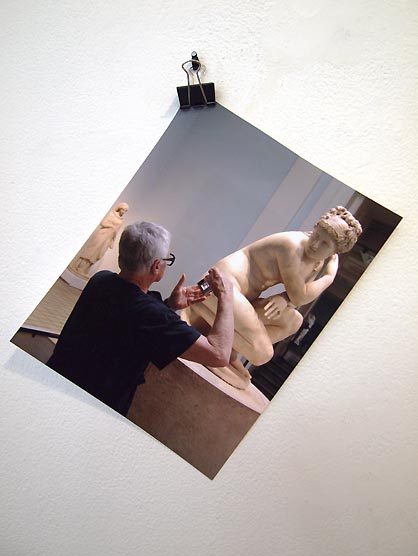 Jim Neidhardt at Blackfish (install photo Jeff Jahn) Next month is National Photography Month, but Portland, over-lapping like a temporal Rule of Thirds into May, has jumped the gun with “Photolucida.” A large number of area galleries are participating, and it is safe to say that there is a little something for every taste; and given the growing popularity of photography, there should be a bump in attendance, and perhaps in sales. However, the commoditization may not be guaranteed, for never before in the history of art has there been a time when a viewer may stand back from the art and say to another, “I could do that.” Of course, such a statement may, on the face of it, be seen as naïve as when the same was said of abstract expressionist painting, except in these last 60 years the notion that everyone is/can be an artist has gained some prominence within art discussions, plus the ubiquity of the digital photo and their availability on the internet for our already image-savvy minds, has certainly helped that notion along. Photo collections of the amateur and professional alike are catalogued and readily available on various websites where we are potentially relegated to an electronic version of the photo albums under Grandma’s coffee table in the living room. The wading through the banal and mundane is a walk amongst clichés that at best are well-framed and exposed, or in other words, technically proficient examples of the world seen ‘as it is’ — or, as in the case of stock photography, how the world needs to be seen — through the lens of a camera that often does most of the work. I would argue that photography has both benefited and suffered from this egalitarian plentitude of pretty pictures. Even the argument of whose photo came first or was done better has little meaning within a plethora of likenesses. (The photographer who cries ‘plagiarism’ these days is more likely a mere egoist.). Of course, there are degrees of perfection and perspective, and a corresponding geometric-like value meter for the best shot of the Grand Canyon from a corralled vantage point, just as there is for a particular snap of any mountain, bed of roses, cornice, or street scene with a catchy billboard that offers a sense of irony or provides a humorous pun on the peopled action. To state the obvious about the obvious: everyone understands a flower as a thing of beauty. 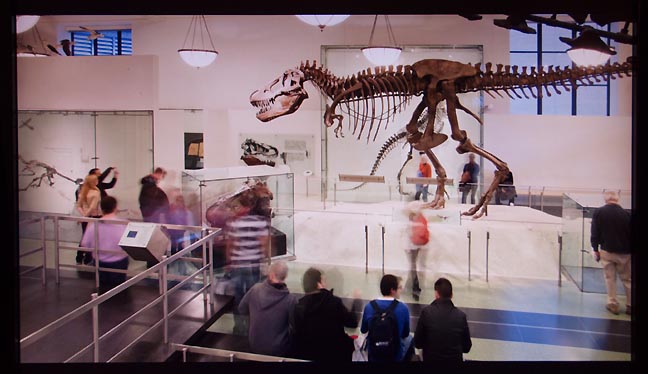
Alan Maertz Tyrannosaurus Rex (video still) at Chambers 916 The conceit in photography lies with the photographers of sufficient technical skill and experience who think this is a concern about which they rise above. Admittedly, some legitimacy is lent when the photos are presented in a gallery, yet, with the potential of more albums waiting in an adjacent building, there is a great temptation to merely breeze through any given exhibition. Fortunately, there are sufficient numbers of photos hung around Portland this month that one is certain to take pause for something special, and for a moment, the tour ceases to be cursory, pedestrian. Nevertheless, the pall of subjectivity must still hang heavy for those who consider themselves more discerning, making it difficult to single out any particular exhibition, let alone a photo that commands to be analyzed within a suitable word count. Nevertheless, and most assuredly against some protested exclusions, mentions should be made: 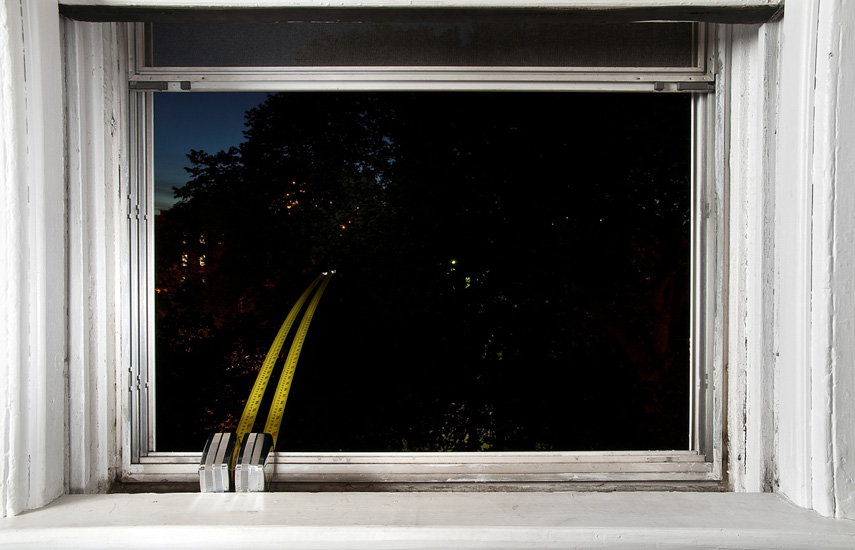 Driving at Night by Kevin van Aelst at Newspace Newspace Center of Photography has a ‘greatest hits’ show, curated by Todd Hito. If you look at a lot of photo sites on the Web, much of this superior work won’t be new to you. However, Kevin van Aelst’s “Driving at Night” jumps out as a piece that is just as much about the physics of photography as it is about sculptural balance and illusion. 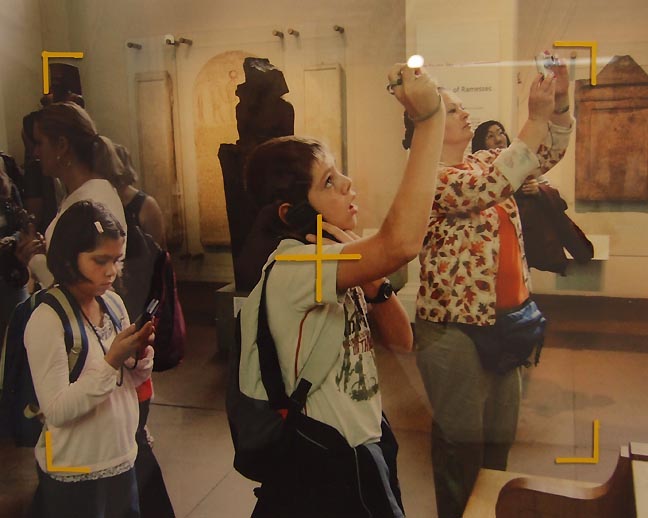 Jim Neidhardt, Museum Four at Blackfish Jim Neidhardt at Blackfish is up to his usual mischief with photo-based meta-clichés of the temptation to photograph people taking photographs, and as such, elicits a smile. For a companion to his exhibit, see Allen Maertz’s videos, “Biodiversity” and Tyrannosaurus Rex” at Chambers Gallery. 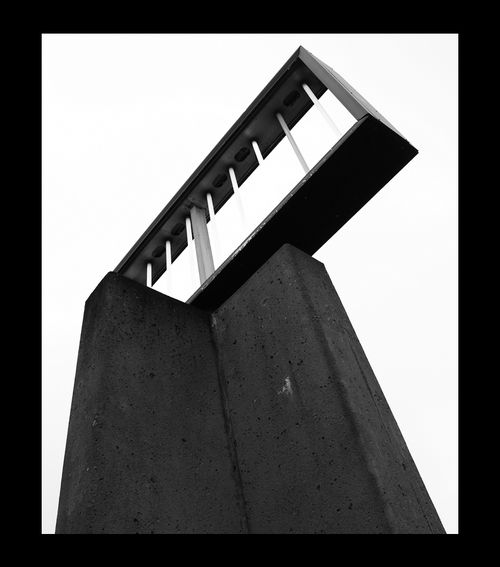 TJ Norris at Anka TJ Norris at Anka Gallery presents a socio-political subtext with his timely (and obviously time-consuming in their composition), rather minimal, formal abstractions of business signs after these monuments to commerce are consigned to rust. 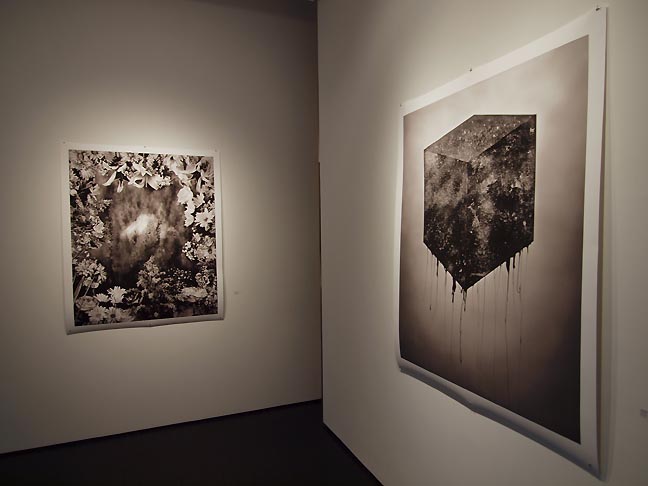 Amjad Faur at PDX Contemporary Amjad Faur is exhibiting his striking, tonally stark images at PDX Contemporary. The flowers pale against the better pieces, “Stone’s Throw,” “The Fattened Calf,” and “Separation Wall,” but his carbon pigment printing technique provides a lush quality to all. And unless one is steeped in the language of contemporary critical theory, stay away from his somewhat turgid artist’s statement. (Even though there is little in the photos to suggest such, Faur’s work is cultural and political conflicts in the Middle East.) It can be argued, of course, that any given photograph of a flower arrangement may have us see those flowers in a way we have not before, and in that, have a renewed appreciation for said plants; but do we arrive at a new understanding/impression of what it is to know a flower? Granted, the intervention of and within the photo gives a signature/imprint of the photographer, yet a finer point is often missed: re-presentation, while a contextualization, is not the same as re-contextualization, and when this oversight occurs, there is little conflict or disparity toward a new whole. In short, so much photography, content to offer up some degree of technical or realist empiricism, lacks a criticality capable of creating much that provides new meaning to the subject matter. Presenting a carefully framed view of an object, scene or person(s) does little to remove the baggage of a readily nameable object-ness of geography, architecture, flora and fauna, or the emotional states of homo sapiens. What may be at hand in this Golden Age of photography is a blurred line between professional and amateur, and subsequently a profound cynicism is thereby spawned from — and within — the egalitarian nature of the medium. When everyone and their mother has some kind of imaging device at-the-ready, shouldn’t we expect from this democratized legion of perspectives more than just ‘a good eye’? Is the pleasure we derive from documenting or viewing a moment and select portion of an otherwise incomplete scene enough? It would seem that these same questions apply equally to those who seek redemption in Photoshop or alternative photographic and printing processes. Either with an apropos nod to process and intervention in post-production, or perhaps reference to another visual genre such as painting, sculpture (installation), theatre, or even photography in which use of the medium is seemingly secondary (conceptual), the journalistic must somehow transform in resonance to become metaphorical. These are not sole criteria (no more than a thesis here fully flushed out), nor are they immune to the criticism of “more of the same.” (With record numbers of arts education programs, much of art suffers in a similar manner.) Still, they may help point a way out of the morass that photography itself has become. The watchful eye is always one of compassion, or rather, has a passion for a world that offers so much to see, both the beautiful and less so; but by virtue of the huge numbers of people now looking for that perfect shot, the stakes have been raised, and with this, the best photography remains that which initiates a sense of wonder in the viewer, as opposed to a measure of spectacle. Posted by Patrick Collier on April 22, 2011 at 10:36 | Comments (1) Comments With the evolution of cameras and humans on a crash course are we becoming photo-sapiens? Is this new found sophistication in image manipulation, depiction and proliferation leading to a golden age or a mire of mediocrity? Is photography as much a language as it is an art form? TJ's show at Anka is the best thing he's done in a decade in Portland... a must for any Ed Ruscha fan (in composition and subject but different as TJ's thing is set in the context of American decline). His photography is perhaps his strongest hand... it is the strongest photography show in Portland at the moment. Other shows: Bluesky is just gorgeous, its photolucida HQ. Open Walls at Portland's newest contemporary photo gallery, Black Box. Holly Andres' show at Charles Hartman disturbs me because Im fixated on the one photo where all the woman with axes seem to be attacking a little blond boy (who looks like me at age 6). You dont see him in any of the other photos... did they turn him into a Jello desert? Holly I love yah and I realize we looked like twins at that age but... your show is freaking me out in an entertaining way. His work is good but Isaac Layman has been officially over exposed in Portland... may we savor his show at Liz's as the last for a while please? Suzanne Seubert + Ron van Dongen at Froelick are as always very nicely displayed and realized bodies of work by exceptional photographers. Also, thanks for bringing up Alan Maertz's videos... I remember when I did The Best Coast survey show I didnt include any photography (because the warehouse had very few walls) and DK crabbed a bit about not having any during the opening... my response was, it's gotta be presented properly and frankly in that show both Harrell Fletcher's and Felipe Dulzades' video works operated a lot like a series of photographs but provided their own support and lighting. There is a kinship between the two and Patrick brought this out. It's under explored as a developing theme. The fact that most cameras both pro and consumer have video capabilities further drives the relevancy of this conflation between still and motion photography. Posted by: Double J Post a comment Thanks for signing in, . Now you can comment. (sign out)
(If you haven't left a comment here before, you may need to be approved by
the site owner before your comment will appear. Until then, it won't appear
on the entry. Thanks for waiting.)
|
| s p o n s o r s |
 |
 |
 |
 |
 |
 |
 |
 |
 |
 |
 |
 |
 |
 |
 |
 |

|
Site Design: Jennifer Armbrust | • | Site Development: Philippe Blanc & Katherine Bovee | |


![[TypeKey Profile Page]](http://www.portlandart.net/nav-commenters.gif)